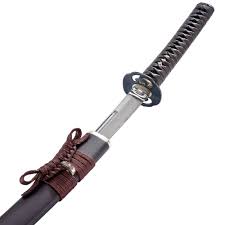Sword steels.
When it comes to Japanese style swords, there are a lot of different sword steels out there these days, some good, some bad. I will talk about a few here.
Stainless Steel: Good for small knives and blades under 12" which are not subject to any impact or shear. Hard but brittle. On anything longer than 12" the likelihood of breaking is very high. Not recommended for anything that's going to contact anything else such as tameshigiri, etc. Good for iaito (unsharpened practice blades for kata practice). Stainless is never differentially tempered so any hamon is strictly aesthetic.

1045-1055 Medium Carbon Steel: This steel can take and hold an adequate edge and remains very tough against breakage. Though it doesn't hold an edge as well as higher carbon content steel (the 45-55 designation tells us these steels are between .45% and .55% carbon content). Swords made from this type of steel are usually best mono-tempered (through-hardened) as there's not really enough carbon to warrant differential hardening of the edge. Excellent for European style swords, machetes and low-end, functional Japanese style swords. Any hamon found on blades of these steel types will be strictly aesthetic.

1060-1095 High Carbon Steel: These are generally the steels you want to see used in your Japanese style sword. The higher the carbon rating, the harder the steel and better the edge retention is. This means the sword will be less likely to bend initially and you will have to resharpen it less often. These steels lend themselves to differential tempering much better than medium carbon steels. Generally the higher the number here, the better the steel. Blades made from these steels are best for traditional blade configurations and for tameshigiri of traditional targets. The hamons (wavy temper line found on Japanese swords) that come from these steel types are quite breathtaking. Some swords using these steel types will use designations like T8 & T10 tool steel. These are basically the same as 1060 & 1095 but use a Chinese system for determining the steel properties when the steel is produced in a Chinese forge.

Silicon Carbon (Spring Steel): A lot of places mention standard high carbon (1060-1095) steels being heat treated to a "spring temper" but this is a misnomer. Real spring steel contains silicon and has it's own numerical designation to denote how much silicon is in the steel. You will usually see this in the first 2 numbers of the blade steel, 5160 - 9260 for example are common high carbon silicon steels. As with regular high carbon steels the 60 in these numbers still designates the amount of carbon in the blade. Silicon spring steel is VERY durable and resists chipping and bending to an amazing degree however much of this tends to be lost when differentially tempering it. Usually real silicon spring steel is best utilized in mono-tempered blades. Many modern style blades like those from Cheness are made of this type of steel and are well suited to backyard cutting and to beginners who don't want to take a blade set because of an improper cut or because they were hacking tree limbs in their backyard :p The hamons on blades made of these types of steel are usually aesthetic and thus will eventually fade/rub off or come off when polishing or sharpening the blade.
4.jpg)
On the subject of tamahagane steel. In Japan's feudal past high quality steel ore was very rare. They had to refine iron sand in huge furnaces to get high quality steel. This was and still is a difficult and costly process. Small bits of ore were then heated & hammered & folded time & again while being combined with more and more bits of high carbon steel as large chunks were hard to come by. Eventually this process leads to blade steel that has relatively uniform tensile properties and a minimum of impurities. Any minor impurities end up so evenly dispersed across the steel that they become inconsequential due to the folding of the steel. In feudal Japan this was the ONLY way to get steel of this quality for the manufacture of swords. Fast forward to modern times... Modern steel manufacturing processes can actually produce better steels for much less money with less impurities than even the best ancient swordsmith could achieve. This is not to take away from the smith's skill mind you. This is only so people realize that you can still get a great sword made from modern steel. There are still great smiths in Japan who still make true Nihonto the same way they have been made for a thousand years and I would never take away from their skill. Someday, I myself hope to own such a fine weapon. The amount of skill and history that goes into making such a blade is really without measure and I would treasure such a blade above all else.

If anyone has any questions about blade steels, feel free to message me (shinobioutfitters@hotmail.com) before purchasing a Japanese style sword and I will be glad to give advice.
Note: images are just for illustration purposes. They do not necessarily relate to the subject matter in the adjacent paragraphs.





4.jpg)












